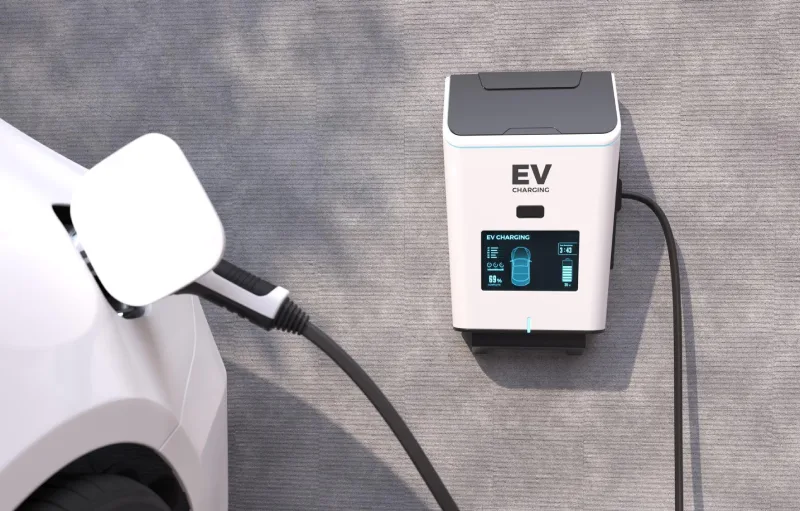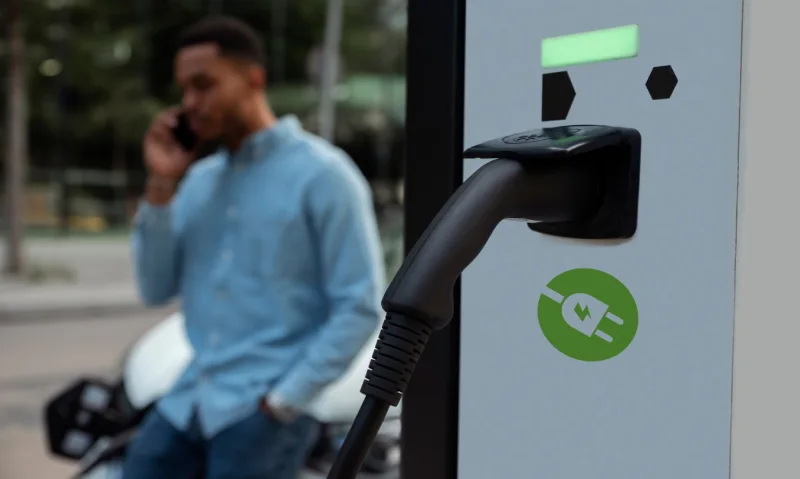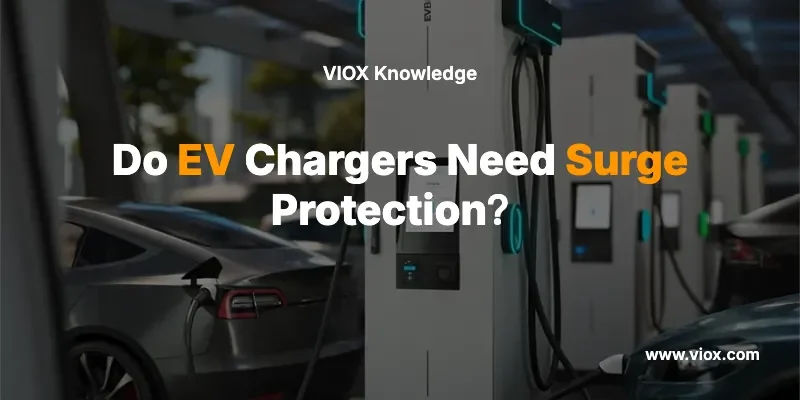Risposta breve: sì, i caricabatterie per veicoli elettrici necessitano di protezione contro le sovratensioni (ma è possibile disattivarla)
In conclusione: Le moderne normative elettriche richiedono l'installazione di dispositivi di protezione da sovratensioni (SPD) per le nuove installazioni di stazioni di ricarica per veicoli elettrici, ma i proprietari di casa possono scegliere di non installarli. Tuttavia, il costo minimo della protezione da sovratensioni ($150-$500) rispetto ai potenziali costi di danni ($2.000+) rende l'installazione un investimento intelligente per proteggere sia il costoso caricabatterie che il veicolo elettrico.
Nuove normative sui cablaggi Nel Regno Unito (18a Edizione, Emendamento 2), entrato in vigore il 27 settembre 2022, il Codice Elettrico Nazionale (NEC) statunitense, edizioni 2020 e 2023, richiede dispositivi di protezione da sovratensioni per i servizi che alimentano le unità abitative, comprese le abitazioni dotate di stazioni di ricarica per veicoli elettrici.
Le normative riconoscono che, sebbene la protezione contro le sovratensioni sia fondamentale per la sicurezza elettrica, spetta ai proprietari di casa l'ultima parola sulle proprie installazioni. Questa guida vi aiuterà a capire perché la protezione contro le sovratensioni è importante, quanto costa e come prendere la decisione giusta per la vostra configurazione di ricarica per veicoli elettrici.
Informazioni sulla protezione da sovratensioni per i caricabatterie per veicoli elettrici
Cosa sono i dispositivi di protezione contro le sovratensioni (SPD)?

Dispositivi di protezione dalle sovratensioni Sono componenti di sicurezza elettrica progettati per proteggere gli impianti elettrici domestici dai picchi di tensione. Un limitatore di sovratensione protegge gli apparecchi elettrici dai picchi di tensione bloccando o cortocircuitando qualsiasi tensione in eccesso. Per quanto riguarda i caricabatterie per veicoli elettrici, gli SPD fungono da linea di difesa fondamentale contro eventi elettrici potenzialmente dannosi.
Pensate a un SPD come a una valvola di sicurezza elettrica. Quando si verifica una sovratensione, che sia dovuta a fulmini, commutazione della rete o guasti alle apparecchiature, il dispositivo rileva la tensione in eccesso e la devia a terra in modo sicuro, impedendo che raggiunga i costosi sistemi di ricarica per veicoli elettrici.
Perché i caricabatterie per veicoli elettrici sono vulnerabili alle sovratensioni

I moderni caricabatterie per veicoli elettrici contengono componenti elettronici sofisticati che gestiscono il complesso processo di ricarica sicura della batteria del veicolo. I caricabatterie per veicoli elettrici si basano su circuiti avanzati per caricare in modo sicuro ed efficiente la batteria dell'auto elettrica, e una sovratensione può sovraccaricare e danneggiare permanentemente tali componenti.
Diversi fattori rendono i caricabatterie per veicoli elettrici particolarmente vulnerabili ai danni da sovratensione:
- Elettronica sensibile: Gli attuali caricabatterie intelligenti includono connettività WiFi, app per smartphone, funzioni di bilanciamento del carico e sistemi di monitoraggio della sicurezza, tutti vulnerabili ai picchi di tensione.
- Esposizione all'aperto: I caricabatterie per veicoli elettrici vengono solitamente installati all'esterno, il che li rende più vulnerabili ai fulmini e ai disturbi elettrici dovuti alle condizioni atmosferiche.
- Circuiti ad alta potenza: I caricabatterie di livello 2 funzionano su circuiti da 240 V con una capacità di 30-50 A, il che li rende obiettivi privilegiati per gli eventi di sovratensione che possono causare danni significativi.
- Connessione continua: A differenza di altri elettrodomestici, i caricabatterie per veicoli elettrici restano collegati all'impianto elettrico 24 ore su 24, 7 giorni su 7, esponendosi costantemente a potenziali sovratensioni.
Requisiti legali: cosa dicono i regolamenti
Regolamenti del Regno Unito (18a edizione, emendamento 2)
Il nuovo Emendamento 2, 18a Edizione, del Regolamento sui Cablaggi è entrato in vigore il 27 settembre 2022, stabilendo che tutti i nuovi circuiti elettrici devono essere dotati di dispositivi di protezione da sovratensioni (SPD). Poiché le installazioni di stazioni di ricarica per veicoli elettrici richiedono nuovi circuiti dedicati, questo regolamento si applica direttamente alle installazioni di ricarica residenziali per veicoli elettrici.
Tuttavia, le normative includono una disposizione importante: i clienti possono scegliere di non avere un dispositivo di protezione da sovratensioni al momento dell'installazione del caricabatterie del veicolo elettrico, se lo desiderano, il che significa che la decisione finale spetta al cliente.
Requisiti chiave del Regno Unito:
- SPD obbligatori per tutti i nuovi circuiti elettrici
- Le installazioni di caricabatterie per veicoli elettrici rientrano in questo requisito
- L'opt-out del cliente è consentito con la documentazione adeguata
- Installazione professionale obbligatoria da parte di elettricisti qualificati
Normative statunitensi (NEC 2020/2023)
Gli Stati Uniti seguono il National Electrical Code, che si è evoluto per richiedere la protezione contro le sovratensioni nelle applicazioni residenziali. La Sezione 230.67(A) del NEC 2023 richiede che tutti i servizi che alimentano le unità abitative siano dotati di un dispositivo di protezione dalle sovratensioni (SPD).
I requisiti NEC includono:
- SPD di tipo 1 o di tipo 2 richiesto per le unità abitative
- La protezione deve essere integrata nell'apparecchiatura di servizio o posizionata immediatamente adiacente
- I requisiti sono stati ampliati nel 2023 per includere unità abitative multifamiliari, dormitori, camere per gli ospiti e suite per gli ospiti
L'adozione statale varia: A febbraio 2023, il NEC 2020 è in vigore in venticinque stati, mentre altri stati utilizzano versioni precedenti. Verificate con l'autorità locale competente i requisiti specifici per la vostra zona.
Standard internazionali e migliori pratiche
Sebbene le normative varino a livello globale, la tendenza verso l'obbligatorietà della protezione contro le sovratensioni riflette la crescente consapevolezza dell'importanza della sicurezza elettrica in un mondo sempre più elettronico. Paesi come Australia, Canada e Germania hanno requisiti simili in fase di sviluppo per gli impianti elettrici residenziali.
Tipi di protezione contro le sovratensioni per i caricabatterie per veicoli elettrici
SPD di tipo 1 (protezione dell'ingresso del servizio)
Gli SPD di Tipo 1 vengono installati a monte del dispositivo principale nel centro di carico e forniscono la prima linea di difesa contro le sovratensioni esterne provenienti dalla rete elettrica. Questi dispositivi vengono in genere installati sul contatore elettrico o sul quadro elettrico principale.
Ideale per:
- Case con linee elettriche aeree
- Aree con frequente attività di fulmini
- Immobili con sistemi di protezione contro i fulmini esistenti
SPD di tipo 2 (protezione del centro di carico)
Gli SPD di tipo 2 sono posizionati sul lato carico del sezionatore principale e rappresentano la scelta più comune per la protezione dei caricabatterie residenziali per veicoli elettrici. Questi dispositivi di protezione da sovratensioni vengono solitamente installati nella scatola dei fusibili dell'abitazione, o nell'unità di consumo, contemporaneamente all'installazione del caricabatterie.
Vantaggi:
- Protegge da sovratensioni sia esterne che interne
- Installazione più semplice durante la configurazione del caricabatterie EV
- Copre l'intero impianto elettrico domestico
- Più conveniente per applicazioni residenziali
SPD di tipo 3 (protezione del punto d'uso)
I dispositivi di Tipo 3 forniscono protezione a singole prese o apparecchiature. I limitatori di sovratensione a spina di Tipo 3 non forniscono da soli una protezione adeguata per i caricabatterie dei veicoli elettrici, ma possono fungere da protezione supplementare.
Protezione del circuito dell'intera casa vs. protezione del circuito dedicato del veicolo elettrico
Secondo la norma NEC 2020, un SPD certificato UL1449 deve essere installato sul quadro elettrico principale in ingresso a 120/240 V CA, fornendo quello che viene definito "protezione da sovratensioni per tutta la casa". Questo approccio protegge la stazione di ricarica del veicolo elettrico e, contemporaneamente, tutti gli altri dispositivi elettrici presenti in casa.
I costi reali: investimento vs. rischio
Costi di installazione SPD
Prezzi nel Regno Unito:
- Dispositivi SPD: intervallo tipico £ 30-£ 160
- Installazione professionale in genere inclusa nella configurazione del caricabatterie per veicoli elettrici
- Piccolo costo aggiuntivo se installato durante l'installazione del caricabatterie EV
Prezzi USA:
- Protezione da sovratensioni decente per tutta la casa: $300 per il dispositivo, $200 per l'installazione
- Costo totale realistico: $500 nella fascia alta
- Alcune installazioni costano solo $250, comprese le parti
Costo dei danni ai caricabatterie dei veicoli elettrici
Senza protezione contro le sovratensioni, i danni elettrici possono essere catastrofici e costosi:
- Sostituzione del caricabatterie per veicoli elettrici: $800-$2.500+ per caricabatterie di livello 2 di qualità
- Elettronica del veicolo: I veicoli elettrici moderni contengono migliaia di dollari in componenti elettronici sensibili
- Danni elettrici domestici: Le sovratensioni possono danneggiare più elettrodomestici e richiedere un cablaggio completo
Se si verificano danni dovuti a una sovratensione, il costo per sostituire o riparare l'apparecchiatura di ricarica danneggiata è notevolmente più elevato rispetto al piccolo costo di un SPD.
Implicazioni relative ad assicurazione e garanzia
Considerazioni critiche: È importante leggere attentamente le clausole scritte in piccolo delle garanzie dei produttori e delle polizze assicurative sulla casa, che potrebbero non essere valide se non viene installato tale dispositivo di protezione.
Molti produttori di caricabatterie per veicoli elettrici e compagnie assicurative potrebbero negare le richieste di risarcimento per danni da sovratensione se non è stata installata un'adeguata protezione. In caso di richiesta di risarcimento, potrebbero non essere erogati pagamenti o prodotti sostitutivi, quindi è importante comprendere l'importanza della protezione contro le sovratensioni elettriche in termini di copertura assicurativa e richieste di garanzia.
Vantaggi oltre la conformità
Proteggere il tuo investimento
Longevità dell'attrezzatura: Gli SPD prolungano la durata delle apparecchiature eliminando sovratensioni elettriche sia grandi che piccole che possono gradualmente degradare i componenti elettronici nel tempo.
Protezione del veicolo: I veicoli elettrici moderni sono essenzialmente computer su ruote. Una sovratensione che penetra attraverso il cavo di ricarica può potenzialmente danneggiare il sistema di gestione della batteria, il computer di bordo o altri costosi componenti elettronici del veicolo.
Affidabilità del sistema: Un'adeguata protezione contro le sovratensioni garantisce prestazioni di ricarica costanti e sicure e riduce la probabilità di guasti imprevisti del caricabatterie.
Pace della mente
Protezione dalle intemperie: Fulmini, guasti alle apparecchiature o ai cablaggi elettrici e il ripristino dell'alimentazione dopo un'interruzione sono tutti fattori comuni che possono causare sovratensioni. Gli SPD offrono protezione contro tutti questi scenari.
Protezione 24 ore su 24, 7 giorni su 7: Anche quando non stai ricaricando attivamente, il caricabatterie del tuo veicolo elettrico rimane collegato al tuo impianto elettrico. La protezione da sovratensioni garantisce un monitoraggio della sicurezza 24 ore su 24.
A prova di futuro: Poiché gli impianti elettrici domestici diventano sempre più sofisticati grazie alla tecnologia per la casa intelligente, la protezione contro le sovratensioni per tutta la casa diventa ancora più preziosa.
Cause comuni di sovratensioni che interessano i caricabatterie per veicoli elettrici

Colpi di fulmine
I fulmini sono tra le cause più comuni di sovratensioni elettriche. Anche i fulmini indiretti sulle linee elettriche vicine possono causare picchi di tensione dannosi attraverso la rete elettrica, raggiungendo la vostra abitazione.
Fattori di rischio:
- Posizione geografica (Florida, Texas e Colorado hanno la più alta attività di fulmini)
- Linee elettriche aeree vs. sotterranee
- Vicinanza a strutture alte o aree aperte
sovratensioni legate alla rete elettrica
Ripristino dell'alimentazione: Quando la corrente elettrica viene ripristinata dopo un'interruzione, l'improvviso afflusso di corrente può creare picchi di tensione.
Commutazione delle apparecchiature: Le aziende di servizi pubblici accendono e spengono regolarmente grandi apparecchiature elettriche, creando potenzialmente sovratensioni che si propagano attraverso le linee elettriche.
Instabilità della rete: L'invecchiamento delle infrastrutture elettriche e l'aumento della domanda possono creare fluttuazioni di tensione che sottopongono a stress le apparecchiature collegate.
Problemi elettrici interni
Ciclo di grandi elettrodomestici: Quando elettrodomestici ad alta potenza, come condizionatori o scaldabagni elettrici, si accendono e si spengono, possono creare sovratensioni interne all'impianto elettrico della casa.
Cablaggio difettoso: Collegamenti elettrici deteriorati o cablaggi danneggiati possono creare pericolosi picchi di tensione che la protezione contro le sovratensioni aiuta a contenere.
Considerazioni sull'installazione
Requisiti di installazione professionale
Solo elettricisti qualificati: È fondamentale che le stazioni di ricarica per veicoli elettrici siano installate da elettricisti qualificati con formazione specifica nell'installazione di punti di ricarica per veicoli elettrici. Lo stesso vale per i dispositivi di protezione da sovratensioni.
Requisiti di certificazione: Cercate elettricisti certificati nell'installazione di caricabatterie per veicoli elettrici, che conoscano le attuali normative elettriche e i requisiti di protezione contro le sovratensioni.
La sicurezza prima di tutto: Maneggiare l'elettricità comporta dei rischi intrinseci, il che sottolinea la necessità di un'installazione professionale.
Strategie di posizionamento ottimali
Installazione del pannello principale: La maggior parte degli SPD residenziali viene installata nel quadro elettrico principale, garantendo una protezione completa per l'intera abitazione, incluso il circuito di ricarica del veicolo elettrico.
Messa a terra corretta: Per prestazioni ottimali, il collegamento a terra dell'SPD deve utilizzare un conduttore dedicato per stabilire la messa a terra dell'edificio/servizio.
Considerazioni sul percorso dei cavi: I cavi più corti tra l'SPD e i conduttori di alimentazione garantiscono una migliore risposta alle sovratensioni.
Scegliere il SPD giusto
Valutazione Joule: Per i caricabatterie dei veicoli elettrici, si consiglia una potenza minima di 2000 joule per gestire l'energia proveniente da sovratensioni significative.
Tensione di serraggio: Per una protezione ottimale specifica per le applicazioni di ricarica dei veicoli elettrici, cercare una tensione di bloccaggio di circa 400 V.
Tempo di risposta: Per garantire una protezione efficace, un buon dispositivo di protezione da sovratensioni dovrebbe reagire in meno di un nanosecondo.
Prendere la decisione: hai bisogno di un SPD per il caricabatterie del tuo veicolo elettrico?
Fattori di valutazione del rischio
Rischio geografico di fulmini: Le aree con temporali frequenti traggono i maggiori benefici dalla protezione contro le sovratensioni. Consultate i dati locali sulla frequenza dei fulmini.
Affidabilità della rete elettrica: Le regioni con infrastrutture elettriche obsolete o con frequenti interruzioni presentano un rischio maggiore di sovratensioni.
Protezione degli investimenti: Quando valuti i costi di protezione, considera il valore combinato del caricabatterie per veicoli elettrici ($800-2.500) e dell'elettronica del veicolo (potenzialmente migliaia di euro).
Quando puoi rinunciare (e perché non dovresti)
Sebbene le normative consentano di non aderire, i consigli più affidabili tendono a includere la protezione da sovratensioni durante l'installazione dei caricabatterie per veicoli elettrici. Il costo minimo rispetto ai potenziali danni rende la protezione da sovratensioni un investimento saggio.
Documentazione di esclusione: Se si decide di procedere senza installare un dispositivo di protezione contro le sovratensioni durante l'installazione, potrebbe essere richiesto di firmare un documento in cui si conferma di essere stati informati dei potenziali rischi.
Raccomandazioni Professionali
Se elettricisti qualificati consigliano l'installazione di un dispositivo di protezione da sovratensioni, vale sicuramente la pena seguire il loro consiglio. Questi professionisti conoscono le condizioni elettriche locali e i requisiti normativi meglio di chiunque altro.
Processo di installazione e manutenzione
Cosa aspettarsi durante l'installazione
Cronologia: L'installazione di un SPD solitamente aggiunge 30-60 minuti all'appuntamento per l'installazione di un caricabatterie per veicoli elettrici.
Interruzione minima: L'installazione richiede solitamente una breve interruzione dell'alimentazione elettrica per consentire il collegamento al pannello principale.
Test: Gli installatori professionisti testeranno l'SPD per garantirne il corretto funzionamento prima di completare il lavoro.
Esigenze di manutenzione continua
Monitoraggio: La maggior parte degli SPD moderni sono dotati di spie luminose che ne indicano lo stato operativo.
Indicatori di sostituzione: Gli SPD possono usurarsi dopo aver protetto dalle sovratensioni e potrebbe essere necessario sostituirli ogni 5-10 anni.
Ispezione professionale: Includere lo stato SPD nelle ispezioni periodiche dell'impianto elettrico.
Domande Frequenti
Il caricabatterie per veicoli elettrici è dotato di protezione da sovratensioni integrata?
I caricabatterie per veicoli elettrici non sono dotati di SPD integrato: l'SPD è un dispositivo esterno installato dall'elettricista, solitamente presso l'unità di consumo. Sebbene alcuni caricabatterie includano funzioni di protezione elettrica di base, non offrono una protezione completa contro le sovratensioni.
Posso installare da solo la protezione contro le sovratensioni?
No. L'installazione di un SPD richiede l'intervento sul quadro elettrico principale e deve essere eseguita solo da elettricisti qualificati e autorizzati. Un'installazione non corretta può comportare rischi per la sicurezza e invalidare le garanzie.
La protezione contro le sovratensioni influirà sulla velocità di ricarica del mio veicolo elettrico?
No. Gli SPD correttamente installati non influiscono sul normale funzionamento elettrico o sulla velocità di ricarica. Si attivano solo in caso di sovratensione per proteggere le apparecchiature.
Cosa succede se scelgo di non usufruire della protezione contro le sovratensioni?
Ti assumi la piena responsabilità finanziaria per eventuali danni causati da sovratensioni al caricabatterie del tuo veicolo elettrico, al veicolo stesso o all'impianto elettrico domestico. Anche le richieste di risarcimento assicurativo e in garanzia potrebbero essere respinte.
Con quale frequenza è necessario sostituire i dispositivi di protezione contro le sovratensioni?
Gli SPD durano in genere 5-10 anni, ma potrebbero dover essere sostituiti prima se hanno protetto da più sovratensioni. I dispositivi moderni includono indicatori di stato che indicano quando è necessaria la sostituzione.
Conclusione: proteggere il tuo investimento in veicoli elettrici
La questione non è se i caricabatterie per veicoli elettrici necessitino di protezione da sovratensioni – le normative elettriche la richiedono sempre più, a ragione. La vera domanda è se si è disposti ad accettare i significativi rischi finanziari e per la sicurezza derivanti dalla rinuncia.
Fattori chiave della decisione:
- Analisi costi-benefici: Protezione $150-$500 contro danni potenziali $2.000+
- Conformità normativa: Richiesto dai moderni codici elettrici con disposizioni di esclusione
- Protezione assicurativa/garanzia: Potrebbe essere richiesto per la validità della copertura
- Tranquillità: Protezione contro eventi elettrici imprevedibili
Il nostro consiglio: Installa un dispositivo di protezione da sovratensioni durante l'installazione del caricabatterie per veicoli elettrici. Gli SPD rappresentano un investimento intelligente, che protegge la tua casa, i tuoi beni e garantisce il rispetto delle normative di sicurezza.
Il costo aggiuntivo minimo offre una protezione completa per uno degli impianti elettrici domestici più costosi, garantendo al contempo la conformità agli standard di sicurezza vigenti. Quando elettricisti qualificati consigliano una protezione contro le sovratensioni, è bene ascoltarli.
Pronti a installare in sicurezza il caricabatterie per veicoli elettrici?
Contatta elettricisti qualificati e certificati nella tua zona, esperti sia nell'installazione di caricabatterie per veicoli elettrici che negli attuali requisiti di protezione da sovratensioni. Richiedi più preventivi che includano la protezione da sovratensioni per assicurarti il miglior rapporto qualità-prezzo per una sicurezza elettrica completa.
Proteggi il tuo investimento. Proteggi la tua casa. Ricarica in tutta sicurezza.
Correlati
Che cosa è un dispositivo di protezione dalle sovratensioni (SPD)
Dispositivi di protezione contro le sovratensioni: pro e contro
Dispositivi di protezione contro le sovratensioni vs. scaricatori di sovratensioni
Dispositivo di protezione da sovratensione Tipo 1 vs Tipo 2 vs Tipo 3


